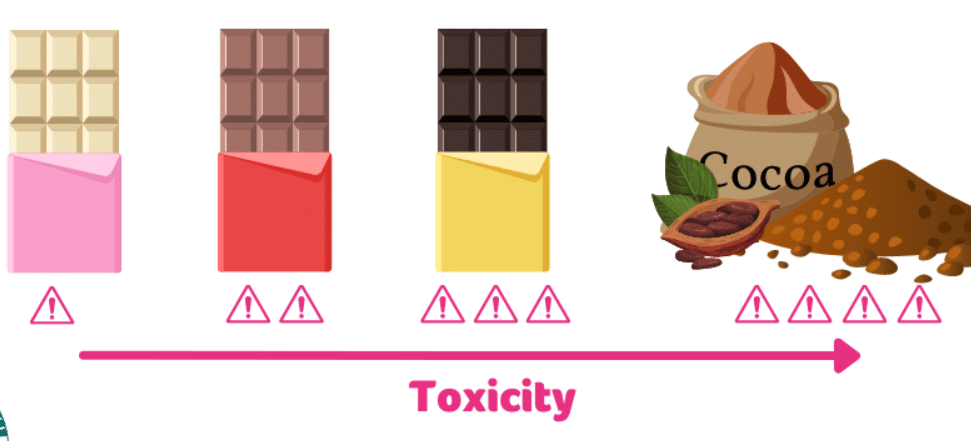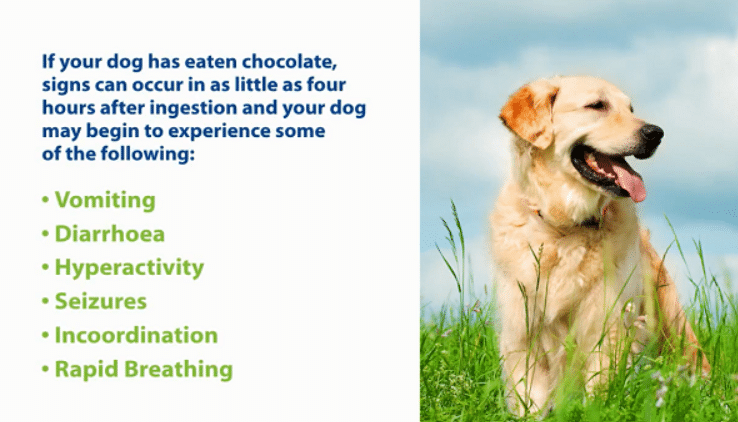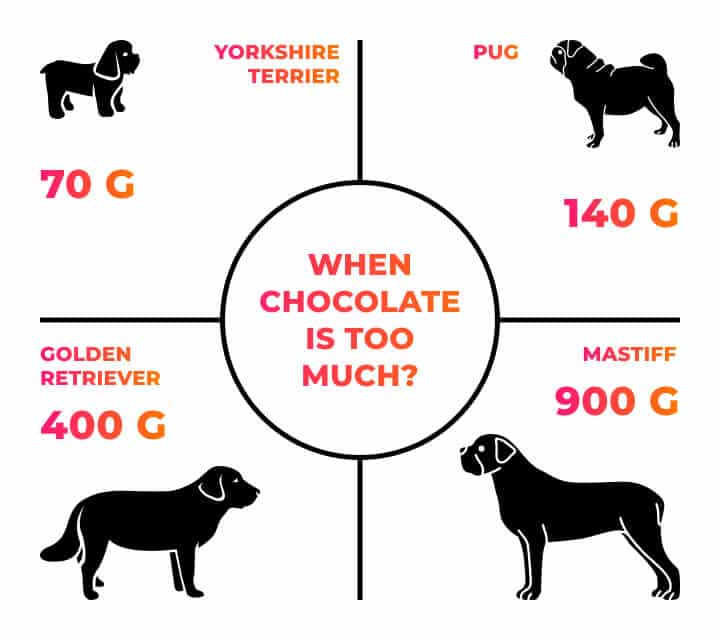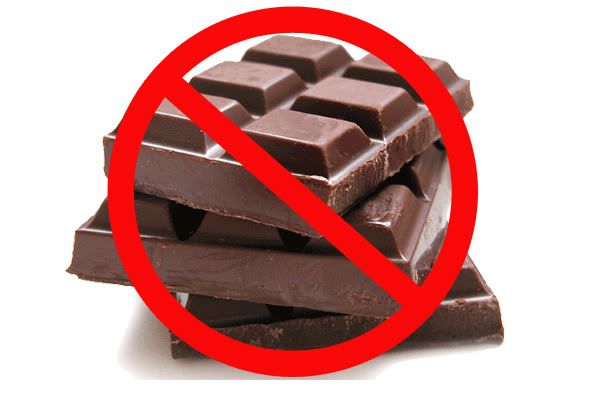Chocolate, a delight for humans, often becomes a difficult indulgence for our canine friends. The risk of chocolate poisoning in dogs is a significant concern for pet owners, as dogs are naturally attracted to sweet flavors. This article sheds light on the various aspects of chocolate toxicity in dogs, from understanding its harmful components to recognizing the symptoms and necessary actions. It aims to provide a comprehensive guide to help dog owners prevent and manage chocolate poisoning, ensuring the safety and well-being of their beloved pets.
Understanding Chocolate Toxicity

Chocolate contains substances like theobromine and caffeine, which are toxic to dogs. The level of toxicity depends on the type of chocolate, with dark chocolate being more dangerous than milk or white chocolate. These substances affect dogs’ central nervous system, heart, and kidneys. Dogs cannot process theobromine efficiently, leading to a build-up in their system, which can be fatal. Awareness of these facts is crucial for dog owners to understand why even a small amount of chocolate can harm their pets.
The effect of chocolate on a dog’s body varies based on the dog’s size and the chocolate type. Larger breeds might tolerate small amounts of chocolate better than smaller breeds. However, no chocolate is safe, and the risk increases with the amount consumed. Recognizing the severity of the situation is vital for dog owners to make informed decisions about their pet’s health and safety.
Recognizing the Symptoms of Chocolate Poisoning

The early symptoms of chocolate poisoning in dogs include vomiting, diarrhea, and restlessness. These signs can appear within hours of ingestion, and their severity depends on the amount and type of chocolate consumed. Dog owners need to monitor their pets closely if they suspect chocolate ingestion.
As the toxicity progresses, dogs may exhibit more severe symptoms like rapid breathing, seizures, and heart failure. These symptoms indicate a critical situation requiring immediate veterinary attention. Timely recognition of these signs can be the difference between life and death for a dog, emphasizing the importance of being vigilant and responsive.
Assessing the Risk: Factors to Consider

When assessing the risk of chocolate poisoning, the size of the dog and the quantity of chocolate consumed are crucial factors. Smaller dogs are at a higher risk as their bodies cannot tolerate even small amounts of chocolate. Additionally, the type of chocolate matters, with darker chocolates posing a greater threat due to higher theobromine levels.
Another factor to consider is the individual sensitivity of dogs to chocolate. Some dogs may exhibit symptoms even after consuming minimal amounts, while others might not show immediate effects. This variability underscores the need for dog owners to err on caution and seek veterinary advice regardless of the quantity ingested.
Immediate Actions to Take If Your Dog Eats Chocolate

If a dog consumes chocolate, the owner’s prompt response is vital. The first step is to determine the type and amount of chocolate ingested. This information is crucial for assessing the level of risk and deciding the next steps. Inducing vomiting might be necessary if the quantity is substantial, but this should only be done under a veterinarian’s guidance.
Contacting a veterinarian is imperative. They can provide specific instructions based on the dog’s size, health status, and the amount of chocolate consumed. In some cases, they may recommend immediate intervention or monitoring at home. The veterinarian must provide accurate and detailed information for the best possible outcome.
Veterinary Interventions for Chocolate Poisoning

Various diagnostic tests may be conducted when a dog is presented to a veterinarian for chocolate poisoning. These can include blood work and a physical examination to assess the dog’s overall health and the severity of the poisoning. The vet may also inquire about the time of ingestion and symptoms observed, as these details are crucial in determining the course of treatment.
The common treatments for chocolate poisoning in dogs include induced vomiting, administering activated charcoal to prevent further absorption of theobromine, and intravenous (IV) fluids to aid in hydration and excretion of the toxin. In severe cases, additional interventions such as medications to control heart rate, seizures, or blood pressure might be necessary. The goal is to stabilize the dog and eliminate the toxin from the body as efficiently as possible.
Prevention Strategies for Dog Owners

Prevention is key to avoiding chocolate poisoning. Dog owners should store chocolate and other harmful food items in secure, inaccessible places. Educating family members, especially children, about the dangers of feeding chocolate to dogs is also important. Dogs can be curious and opportunistic eaters, so ensuring chocolate is out of their reach is a critical preventive measure.
Training dogs to avoid eating unknown or harmful foods is another effective strategy. This can include commands like “leave it” or “drop it,” which can prevent a dog from ingesting chocolate accidentally. Additionally, providing safe and healthy alternatives to chocolate can satisfy a dog’s craving for treats without posing any health risks.
Understanding Myths vs. Facts About Chocolate and Dogs

Several myths surround chocolate poisoning in dogs, such as the belief that a small amount of chocolate is harmless. This myth is dangerous as even small quantities can be toxic, depending on the dog’s size and the type of chocolate. Dog owners need to understand the facts and not underestimate the risk.
Another common myth is that all dogs react the same way to chocolate. The truth is that each dog’s reaction can vary based on several factors, including their size, overall health, and the amount and type of chocolate consumed. Dog owners should always seek professional veterinary advice rather than relying on anecdotal evidence or internet myths.
The Dangers of Chocolate Poisoning Are Real
In conclusion, chocolate poisoning in dogs is a serious issue that requires awareness and prompt action from dog owners. Understanding the risks associated with chocolate consumption, recognizing the symptoms of poisoning, and knowing the immediate steps to take are crucial for the safety of our canine companions. As responsible pet owners, we must ensure our pets’ environments are safe and seek professional help when needed. Ultimately, the well-being and health of our dogs depend on our vigilance and informed care.